The Art of Keeping People Away
Posted on October 18, 2019Once I heard about the idea of Hostile Design, I couldn’t help but notice it everywhere. At the time, I lived in Vancouver, Canada and I frequently found myself waiting on East Hastings street for a bus to take me downtown. The issue is, of course, multilayered and complex, but for simplification purposes, this is an area that the homeless population has been pushed into from multiple directions. It will surprise you if you come upon it without expectation due to the sheer number of people who can be found just hanging around with nowhere else to go. For a city that has a policy of preventing harm in this area in terms of a police tactic (rather than arresting people for illegal activity, they are simply present to ensure no one is hurt) and which is an advocate for safe injection sites, it sure has a lot of examples of hostile design that frankly don’t seem to deter those targeted from using certain public spaces, and make it uncomfortable for all people who are now waiting for the bus in the typical Vancouver rain.
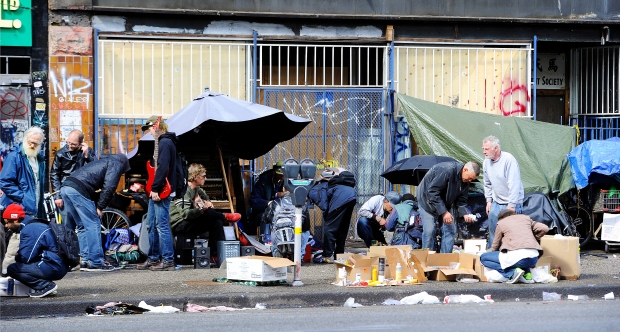
[Left] Van Manen, Mark. 2015. Open street market continues to grow on the north side of Hastings Street between (Carrall and Columbia) in Vancouver on May 5, 2015. Image. http://www.theprovince.com/street+vendors+their+supporters+protest+removal+from+east+hastings+block/11555311/story.html.
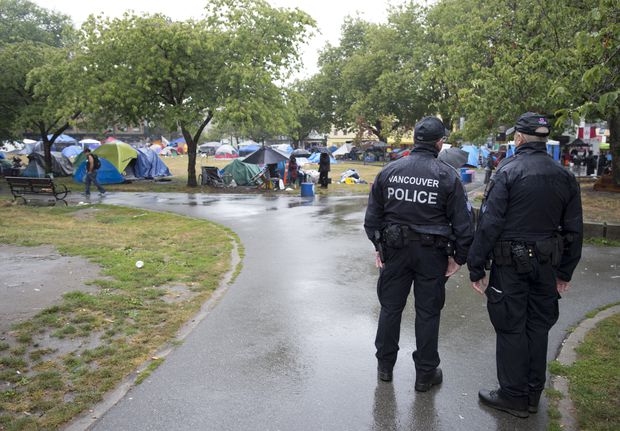
[Right] Hayward, Jonathan. 2019. Vancouver Police Officers Watch Over Tent City At Oppenheimer Park In Downtown Vancouver, On Aug. 21, 2019. Image. https://www.theglobeandmail.com/canada/british-columbia/article-situation-at-tent-city-in-oppenheimer-park-is-deteriorating-vancouver/.
I think I know what Hostile Design is, but jog my memory please…
Hostile Design, also known as Defensive Design, is a reaction to this exaggerated concern that all public spaces will be overrun by impoverished drug addicts whose mission it is to spread disease while asking you for spare change and sleeping at the bus stop. Simply put, Hostile Design is “a form of urban design that aims to prevent people from lingering in public spaces.”1 The aim of such design is to deter certain groups of a community from using the space, most often aimed at people without homes, skateboarders, and teenagers.
Examples go a long way, just saying.
Hostile design comes in many forms. The first are objects that are specifically designed to deter certain people and behaviors. A classic example is the Camden Bench which is designed to prevent people from sleeping or skateboarding on it but frankly, is also hostile to the eyes and struggles to function as a bench.
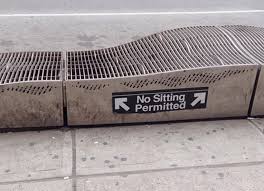
[Left] @lili_yamz. Hostile Design Bench. 2018. Image.
[Right] Camden Bench, an award-winning piece of hostile architecture designed to prevent sleeping, littering, skateboarding, drug dealing, graffiti, and theft. 2017. Image: https://www.reddit.com/r/HostileArchitecture/comments/69ro8d/the_camden_bench_an_awardwinning_piece_of_hostile/.
The second is when objects are purposefully retrofitted to deter specific groups and activities. Examples of this can be seen everywhere, if you look closely. They are things like spikes added to window sills to prevent people from sitting, planters being strategically placed in nooks where people might want to stand for a bit, or arms being added to the middle of benches to prevent people from laying down (or skateboarding). An extreme example has even extended to excluding birds from their natural habitat by placing an inordinate amount of spikes in a Bristol suburb tree1.

Garrett, Jennifer. Our war on wildlife: now birds are not allowed in trees…?! 2017. Image: https://www.cnn.com/style/article/new-dean-harvey-james-furzer-hostile-architecture-debate/index.html
The third common form of hostile design is to take something away. In Vancouver, on East Hastings street, the roof panels from many bus stops have been taken away, leaving an empty frame of steel that protects no one from the constant rain. In London, “there was a lot of pressure from local residents to not install anymore benches, because public areas can become hangouts.”1 It’s a simple design strategy; if there is nothing to sit on, no one will sit. Another classic example is the many plazas which are designed by developers who are obligated to create a public space in exchange for developing a taller building. They often design the areas to be cold and concrete-filled with no place to sit, to deter people from hanging out and to create a sense that it is private rather than public.
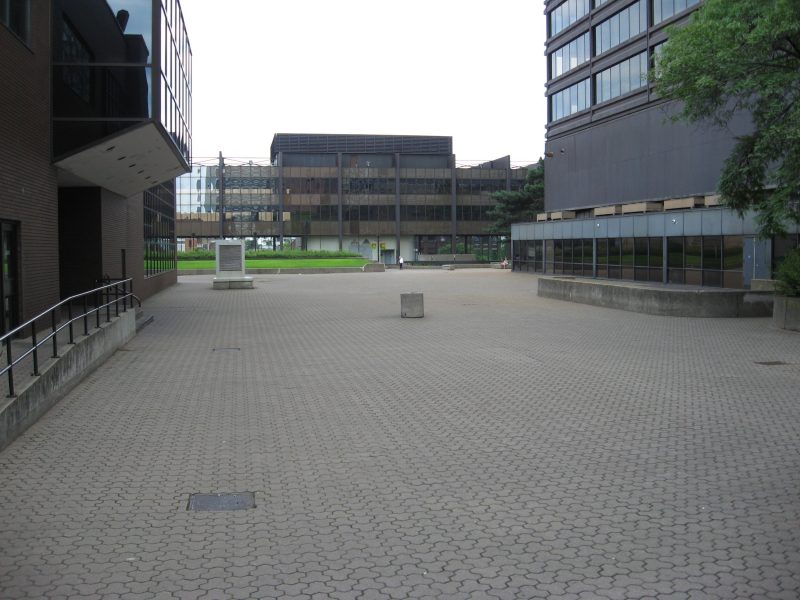
Jackson Square Plaza. 2013. Image. http://everydaytourist.ca/2013/tag/art+districts.
The fourth form is based on auditory experience. If you are trying to dissuade teenagers from hanging out in a space, play some Mozart or maybe a high pitched frequency that only those under age 20 can hear. If you are trying to prevent people from sleeping in a space, make sure it is noisy all the time.
Why should I care about this again?
Hostile design is a problem for multiple reasons: it is hostile towards the most vulnerable people in our community, it harms everyone who uses public space, not just those it is typically intended to deter, and it is a band-aid solution to a wicked problem that is further entrenching our society in class power dynamics.
Hostile design is a form of symbolic violence. Symbolic violence is “the imposition on subordinated groups by the dominant class of an ideology which legitimates and naturalizes the status quo.”3 Hostile design reproduces the power dynamic between classes in the public realm, a space that is supposed to be equally accessible by all, and thereby reinforces the unjust conditions of the lower class. By placing benches that are not only uncomfortable to sit on, but impossible to sleep on, we are telling people that may be homeless that they are not welcome.
No matter whom hostile design is aimed at and whether you believe that it is morally right to dissuade any one group from using a space, hostile design makes spaces uncomfortable for everyone. Stuart Semple, advocate for raising awareness of hostile design writes, “It often attacks the most vulnerable people in our community, regularly the homeless. It sends out a very clear signal, that certain people aren’t wanted. We all end up with brutal looking, unfriendly public spaces.”2 Hostile design is nonsensical in that it harms everyone and has a positive effect on very few people or possibly no one. Andreou writes, “The psychological effect is devastating [for those the architecture is designed against]…Ironically, it doesn’t even achieve its basic goal of making us feel safe.”4 Whichever form of hostile design is implemented, it’s pretty clear what group (or animal) is being deterred and more so than the physical aspect of the design, the emotional trauma of being excluded is harmful. In addition, these spaces are now unwelcoming to all members of society who may want to hang out, relax, and chat with a stranger. In the end, no one is gaining anything and everyone is losing something.
Hostile designs are intervening (negatively) in the wicked problems of poverty and inequality. Hostile design is at best, a band-aid and at worst, an attempt to “exclude those who are creating sympathetic feelings in us.”5 Donna Haraway suggests in her book Staying with the Trouble that the best solution to a wicked problem, rather than admitting defeat and giving up or taking the view that technology will save us, is to simply “stay with the trouble”6, meaning immerse ourselves in the depths of an issue in order to glean possibilities for improving the situation over time. I see Haraway’s advice as implying we should take away the band-aid of hostile design and simply live our lives mixing with groups of every class in public space knowing that by doing so, we will gain a greater understanding of the wicked problems at play.
Ethical Considerations
Why do designers and urban planners think hostile design strategies are ok? What are the ethics of design practice? One of Karl de Fine Licht’s arguments in his paper titled “Hostile Urban Architecture: A Critical Discussion of the seemingly offensive art of keeping people away” is that a positive effect for a large number of people outweighs a negative effect on a small number of people. He argues, “assuming that we give greater priority, but not absolute priority, to the worse-off, it seems evident that we will have cases in which the potential impact on the better-off will trump the negative effects on the worse-off.”5 I disagree with this on ethical grounds in that I believe designers should follow the maxim “First, do no harm,” just as our medical practitioners promise. The ethical practice of design is a larger topic that needs to be discussed, but I offer Do No Harm as a starting point. As Horst Rittel argues, designers are fully accountable for their actions when implementing solutions to wicked problems.7
So, where do we go from here? A Framework for Hospitable Design
If we pause for a minute and really think about the implications of hostile design, we see how absurd it is. James Furzer, an architect who is an advocate for combatting hostile design, comments, “Is it really a bad thing that you’re encouraging people to hang around those spaces? Is that not what architecture and design are about? If we designed a building where people didn’t want to stay for too long, because it’s hostile and uncomfortable, have we succeeded in our jobs as architects? I don’t think so.”1 So the question becomes, how can we create a framework for encouraging Hospitable Design? I first want to note that people can always find creative ways to use even the most hostile of spaces, and that I think this is an important action in rebelling against hostile design. Note the skateboarders and the sleeper (both activities it was meant to prevent) on the Camden bench shown below, not to mention the people sitting (the activity it was meant to encourage) in an awkwardly uncomfortable way.

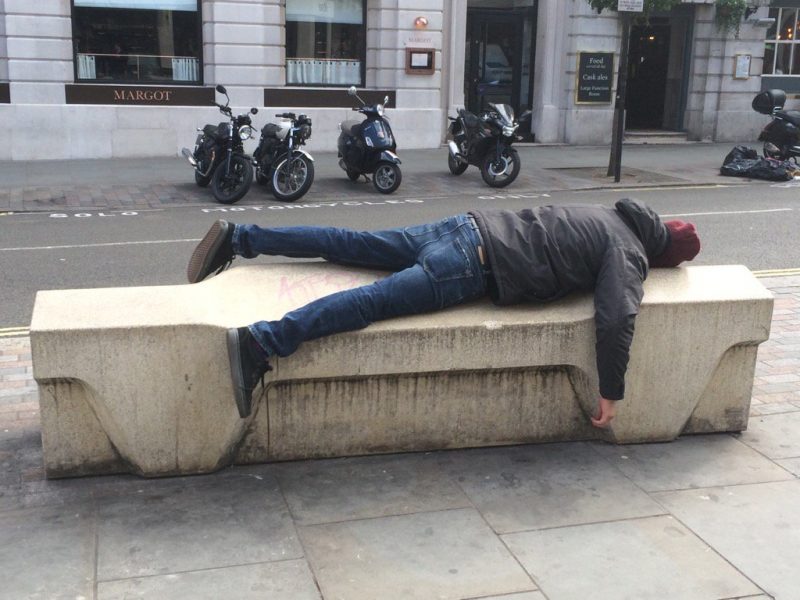
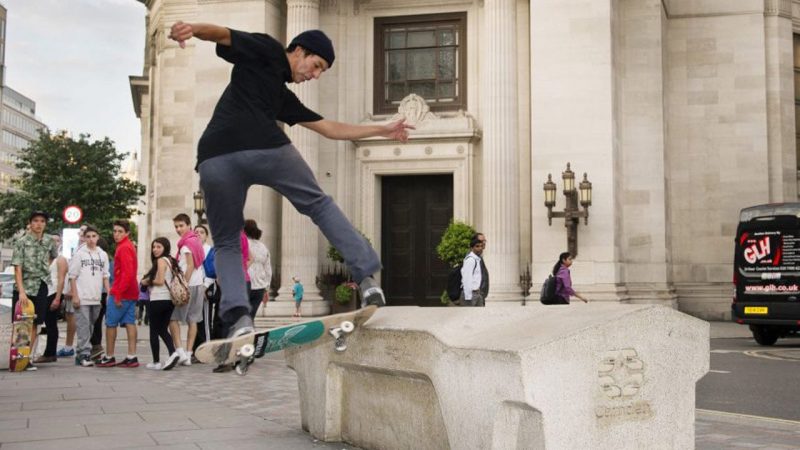
[Left] The Camden Bench, an award-winning piece of hostile architecture designed to prevent sleeping, littering, skateboarding, drug dealing, graffiti, and theft. 2017. Image: https://www.reddit.com/r/HostileArchitecture/comments/69ro8d/the_camden_bench_an_awardwinning_piece_of_hostile/.
[Middle] Neale, Graham. Design flaw in the #CamdenBench as man demonstrates his ability to sleep on it. 2016. Image: https://twitter.com/hashtag/camdenbench.
[Right] Perraudin, Frances and Quinn, Ben. Can you skate on a Camden bench?. 2014. Image: https://www.theguardian.com/lifeandstyle/video/2014/jun/13/can-you-skate-on-camden-bench-video.
Beginning a Hospitable Design Framework
- A good starting point is to be aware and raise awareness for these actions in public space. Stuart Semper is attempting to orchestrate widespread awareness through his project which encourages people to flag examples of hostile design by placing a “Design Crime” sticker on it and posting a picture online.2
- Rather than designing spaces to discourage bad behavior, let’s flip this mantra and design spaces to encourage good behavior. James Furzer notes, “I feel we need to design spaces that encourage good behavior — and turn antisocial behavior into welcoming behavior. Ultimately, architecture isn’t the cure of homelessness. There’s a much greater issue with governments, properties and land laws.” 1 When we flip the mantra, we focus our energy on creating positive things which are more likely to lead to positive outcomes than are hostile designs.
- Let’s create hospitable, welcoming spaces where everyone wants to hang out. William H. Whyte laid out how to do this pretty clearly back in 1979 with his documentary “The Social Life of Small Urban Spaces.”8 Narrated in a hilariously monotone voice, it advises of the necessity of ample seating and seats which are moveable. Surely by now there are many more voices which can add to that narrative of creating warm, welcoming public spaces. It is by now also well correlated, and noted in books such as Happy City9, the relationship between more populated spaces being safer as well as urban spaces being places where people forge human connections which increase their mental well-being.
- Let’s stop ignoring the wicked problem. Furzer says, “if we’re excluding (the homeless) from sleeping on benches, then we need to include them somewhere else. We need to start designing our cityscapes with some sort of inclusive, secure areas. We just need somewhere they can get the security.”1 The truth is, we can’t improve issues of inequality and poverty through creating Hostile or Hospitable Design, but we can use these as a lesson to zoom out and consider how we can contribute to a better way forward.
-DK
References:
1 Lo, Andrea. 2019. “When Hostile Architecture Attacks Nature”. CNN Style. https://www.cnn.com/style/article/new-dean-harvey-james-furzer-hostile-architecture-debate/index.html.
2 “Hostile Design”. 2019. HostileDesign.org. https://www.hostiledesign.org.
3 “Symbolic Violence – Oxford Reference”. 2019. Oxfordreference.Com. https://www.oxfordreference.com/view/10.1093/oi/authority.20110803100546777.
4 Andreou, A. 2015. “Anti-homeless spikes: Sleeping rough opened my eyes to the city’s barbed cruelty”. The Guardian, 19. www.theguardian.com/society/2015/feb/18/defensive-architecture-keeps-poverty-undeen-and-makes-us-more-hostile
5 De Fine Licht, Karl Persson. 2017. “Hostile Urban Architecture: A Critical Discussion Of The Seemingly Offensive Art Of Keeping People Away”. Etikk I Praksis – Nordic Journal Of Applied Ethics 11 (2): 27. doi:10.5324/eip.v11i2.2052.
6 Haraway, Donna J.. Staying with the Trouble : Making Kin in the Chthulucene. North Carolina: Duke University Press, 2016. Accessed October 17, 2019. ProQuest Ebook Central.
7 Horst W. J. Rittel, and Melvin M. Webber. “Dilemmas in a General Theory of Planning.” Policy Sciences 4, no. 2 (1973): 155-69. http://www.jstor.org.libproxy.newschool.edu/stable/4531523.
8 Whyte, William H. 1980. The Social Life Of Small Urban Spaces. Film. New York: Municipal Art Society of New York.
9 Montgomery, Charles. 2013. Happy City. The Science And Story Of Urban Wellbeing. London: Allen Lane.
10 Boehnert, Joanna and Onafuwa, Dimeji. “Design as Symbolic Violence: Reproducing the ‘isms’ + A Framework for Allies”. Intersectional Perspectives on Design, Politics, and Power (2016).